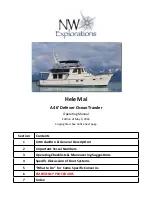
105
Routine Maintenance
• Stainless Steel can normally be cleaned and
protected by using a high quality boat or au-
tomotive wax or a commercial metal cleaner
and protectant.
Never do the following on stainless steel:
• Do not use coarse abrasives like sandpaper or
steel wool which may actually cause rusting.
• Do not use acids or bleaches which may etch
the naturally occurring protective coating.
• Do not leave stainless steel in contact with
iron, steel or other metals which cause con-
tamination leading to rust or corrosion.
CAUTION
UNDER NO CIRCUMSTANCES SHOULD ANY ABRASIVE
MATERIALS SUCH AS SANDPAPER, BRONZE WOOL, OR STEEL
WOOL BE USED ON STAINLESS STEEL. DAMAGE TO THE
HARDWARE WILL RESULT.
Anodized Aluminum Surfaces
Anodized aluminum should be washed periodi-
cally with soap and water to keep it clean. If the
boat is used in saltwater or polluted water, the
aluminum should be washed with soap and water
after each use. Saltwater allowed to remain on
anodized aluminum will penetrate the anodized
coating and attack the aluminum.
Hardtops, bimini tops or T-tops with canvas and/
or fiberglass tops require special attention to the
anodized aluminum just below the top. This area
is subject to salt build up from salty condensation
and sea spray. It is also frequently overlooked
when the boat is washed and will not be rinsed by
the rain. Consequently, the aluminum just below
the top is more likely to become pitted than the ex-
posed aluminum on the structure. Make sure the
aluminum in this area is washed frequently with
soap and water and rinsed thoroughly. Pay par-
ticular attention to places where the top material
or lacing contact the frame. Once a month coat
the entire frame with a metal protector made for
anodized aluminum to protect against pitting and
corrosion caused by the harsh effects of saltwater.
Do not use automotive or boat wax designed for
paint or gel coat on anodized aluminum. The wax
can contaminate the aluminum and damage the
anodized surface.
CAUTION
ONE DRAWBACK TO METAL PROTECTORS IS THAT THEY CAN
MAKE THE METAL SLIPPERY. THEREFORE, THEY SHOULD BE
NOT BE USED ON TOWER LADDERS, STEERING WHEELS AND
OTHER AREAS WHERE A GOOD GRIP AND SURE FOOTING IS
IMPORTANT.
Stains can be removed with a metal polish or
fine polishing compound. To minimize corrosion,
use only high quality stainless steel fasteners on
aluminum fabrications. Isolate the fasteners from
the aluminum by using fiber washers and caulking
compound or Tef Gel to bed hardware and fas-
teners mounted to aluminum fabrications. If the
anodized coating is badly scratched, it will require
special attention and more frequent cleaning to
the damaged area. With proper care, anodized
aluminum will provide many years of service.
Powder Coated Aluminum
Powder coated aluminum should be washed peri-
odically with soap and water to keep it clean. If
the boat is used in saltwater or polluted water,
the aluminum should be washed with soap and
water after each use. Saltwater allowed to remain
on powder coated aluminum will penetrate the
coating and attack the aluminum, usually around
fasteners and hardware mounted to the aluminum.
Pay special attention to the area just below the
top. This area is subject to salt buildup from salty
condensation and sea spray. It is also frequently
overlooked when the boat is washed and will not
be rinsed by the rain. Consequently, the powder
coating near fasteners and hardware mounted
just below the top is more likely to be attacked by
the salt and become corroded than the exposed
areas on the structure. Make sure the aluminum
in this area is washed frequently with soap and
water and rinsed thoroughly. Pay particular atten-
tion to places where the top material and lacing
contact the frame.
Once a month check the entire frame for damaged
powder coating and corrosion around fasteners
and hardware. Nicked or badly scratched powder
coating can be sanded and touched up with enamel
paint. Corrosion around fasteners will have to be
sanded, then touched up with paint. The fasteners
will require fiber washers and sealing with caulk
or Tef Gel to isolate the fastener from the alumi-
num and prevent damage to the paint or powder
Summary of Contents for 24 Bay
Page 1: ...Owner s Manual 24 26 Bay...
Page 2: ...2 Revision 0 11 17 2015...
Page 14: ...14 NOTES...
Page 20: ...20 NOTES...
Page 23: ...23 Operation...
Page 36: ...36 NOTES...
Page 52: ...52 NOTES...
Page 68: ...68 NOTES...
Page 78: ...78 NOTES...
Page 100: ...100 NOTES...
Page 110: ...110 NOTES...
Page 116: ...116 NOTES...
Page 117: ...117 SCHEMATICS Appendix A CV 004 Hardtop Panel Rev B...
Page 118: ...118 Schematics CV 005 Console Harness Rev E...
Page 119: ...119 Schematics CV 006 Deck Harness Rev F...
Page 120: ...120 Schematics CV 007 Helm Switch Panel Command Link Plus...
Page 121: ...121 Schematics CV 009 Hardtop Rev C...
Page 122: ...122 NOTES...
Page 123: ...123 24 Bay Designated Occupant Positions X X X X X X X X Occupant Seating Appendix B...
Page 124: ...124 Occupant Seating 26 Bay Designated Occupant Positions X X X X X X X X X...
Page 129: ...129 MAINTENANCE LOG Appendix D Hours Date Dealer Service Repairs...
Page 130: ...130 Maintenance Log Hours Date Dealer Service Repairs...
Page 131: ...131 Maintenance Log Hours Date Dealer Service Repairs...
Page 132: ...132 Maintenance Log Hours Date Dealer Service Repairs...
Page 133: ...133 Maintenance Log Hours Date Dealer Service Repairs...
Page 134: ...134 Maintenance Log Hours Date Dealer Service Repairs...
Page 135: ...135 Appendix E BOATING ACCIDENT REPORT...
Page 136: ...136 Boating Accident Report...
Page 137: ...137 Boating Accident Report...
Page 138: ...138 NOTES...
Page 140: ...140 NOTES...
Page 145: ...CAUSE AND SOLUTION...
Page 146: ......
Page 147: ...Crevalle Boats Littoral Marine LLC 1520 Industrial Drive Wildwood FL 34785...
















































